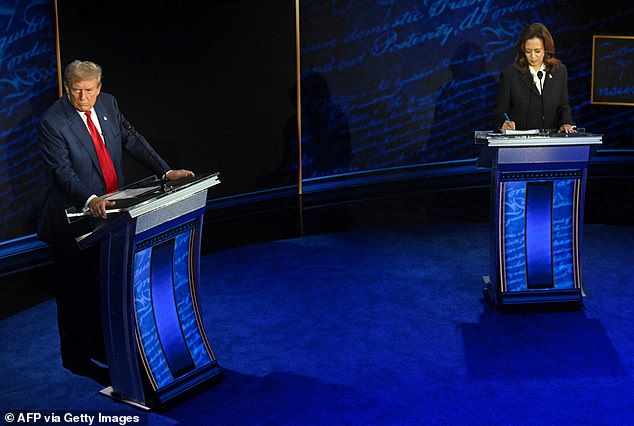Body language experts have shared the ‘gestures’ that may have lost Kamala Harris the presidential election – from her posture that ‘implied inner weakness’ to her ‘passive-aggressive and sarcastic smirk.’
Kamala, 60, spent the last four months campaigning across the country in a bid to become the 47th President of the United States.
But it was revealed on Tuesday that she had lost to Donald Trump – and according to UK-based body language analyst Judi James, some of her movements might have put off voters.
She analyzed the mannerisms that Kamala used throughout her campaign exclusively to DailyMail.com, and broke down which ones may have contributed to her ‘downfall.’
Judi noted that the public tends to ‘distrust’ someone who appears like they are ‘getting it all right,’ but will lean towards ‘someone who shows flaws,’ which is why some people may have been drawn more to Donald, 78, than to Kamala.

‘Our subconscious picks up on many non-verbal traits, adds them to the verbal message, and starts to come to conclusions,’ she explained.
‘Sensation is a huge factor in electoral success or failure. A political leader has to make us feel in certain ways to win our vote.’

Judi explained that Kamala’s posture may have ‘implied inner weakness or a lack of determination.’
She pointed out that the Vice President often used the ‘broken wing wrist position,’ which is when someone’s ‘hand hangs from bent, weak-looking wrists.’
‘When we see our politicians looking powerful and strong we like to see a power extension that takes the line of strength from the chest and shoulder right down to the fingertips,’ shared Judi.
‘She often looked like she was drying her nail varnish when she should have been using fist or baton rituals to imply authentic knowledge and power.’
The expert pointed out that Kamala often took ‘long pauses’ to ‘look around at the audience’ during her speeches – a ‘technique often used by great speakers’ to warn people that ‘something really great was about to come out of their mouth.’
But Judi said Kamala would often fail to follow the move up with something ‘profound’ – and she theorized that her wrong use of the gesture might have ultimately made her ‘messages’ seem ‘incongruent.’




‘Kamala has a love of word salads, speaking a lot of dialogue that barely comes to a point,’ she said.
‘The blend of ‘important’ body language and word salads began to feel like a cheat. When we feel a discrepancy, we begin to seek clarification or we just turn off.’
Judi also claimed that Kamala’s interactions with her husband, Doug Emhoff, were a ‘low point.’
‘Doug’s non-verbals defined him as a dominant alpha male come to congratulate but also take control over his woman,’ she analyzed.
‘His protective arm around her shoulders, his puffed chest and the way he would lead her across the stage as though she’d been out on loan.
‘For her last speech, he even crooked an arm so they walked off with her looking like he was leading her away to her retirement.’
During the debate between Donald and Kamala in September, the Vice President was often seen laughing outwardly at claims that he made.
And Judi added that laughter can ‘produce negative responses’ from viewers if it’s used at the wrong time.


‘Laughing too much and too often when your audience feels it is suffering will produce negative responses,’ she warned.
‘A reputation for humor can be a positive trait but the visual illustration of that sense of humor needs to be used wisely.’
A second body language expert named Jamie Wall also spoke to DailyMail.com about Kamala’s movements, and her reiterated Judi’s claims.

Jamie theorized that the 60-year-old was trying to use ‘humor to diffuse tension,’ but added that laughter can ‘create an emotional imbalance’ and ‘undermine important topics’ if used at the wrong time.
He also pointed out that Kamala often had a ‘sarcastic smirk’ on her face when she would reference her competitor, which he explained may have turned some people off.
‘Excessive sarcasm can create a negative environment, making interactions feel passive-aggressive,’ he shared.
In addition, Jamie noted that Kamala often rested her chin on her hand, which he said made her come off as ‘doubtful about the topic at hand.’
‘In negotiations or discussions, it’s crucial to be aware of how such nonverbal cues might be interpreted,’ he added.
‘Use this gesture thoughtfully. While it can indicate critical thinking, it may also suggest uncertainty, which can affect the overall tone of the conversation.’
